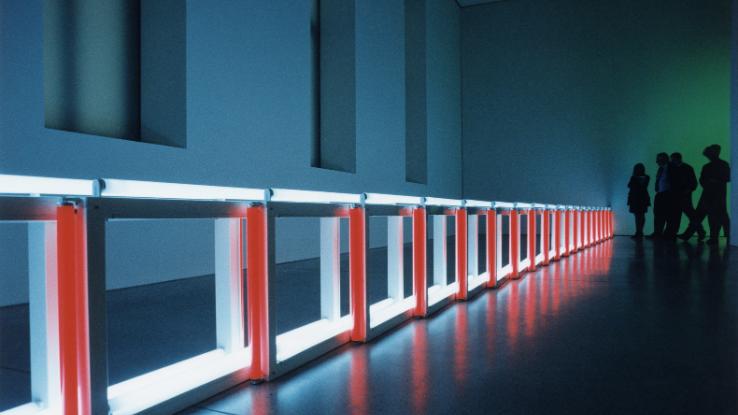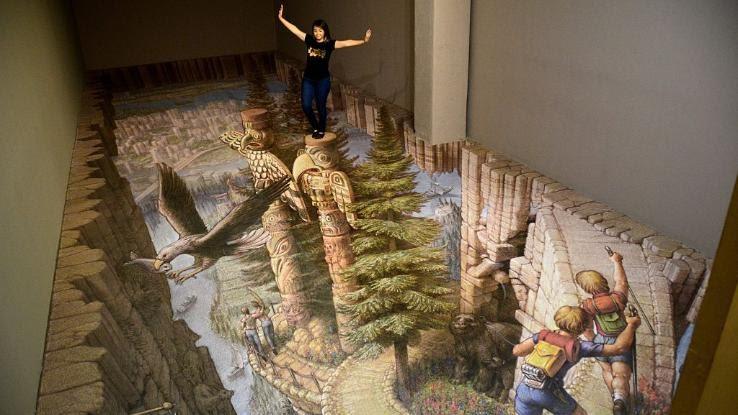how to draw a 3d shopping cart

What's the divergence between 2-dimensional (2nd) and three-dimensional (3D) art? In general, 3D art incorporates height, width, and depth, whereas second art tends to be limited to a flat surface. Pottery and sculptures are good examples of 3D art, while paintings, drawings, and photographs are technically all confined to two dimensions. Nonetheless, folks who work on paper or canvas often create the illusion of the third dimension in their work. And then, how exercise they return such lifelike art? To notice out more, we're delving into the history of 3D art and the theories behind it.
Aspects of 3D Art
Every bit Artdex puts it, "3-dimensional art pieces, presented in the dimensions of top, width, and depth, occupy physical infinite and can exist perceived from all sides and angles." Some types of 3D fine art, such as sculpture, pottery, and jewelry, have been effectually since the kickoff of fourth dimension, while other iterations are relatively new.

When it comes to 3-dimensional works, there's a lot of terminology to pin down. For example, all truly iii-dimensional works take volume — or the "quantity of 3-dimensional space enclosed past a airtight surface." Additionally, 3D art has mass — this kind of intrinsic, tangible weight. Of form, at that place are variations in but how 3D a work is — and a variety of terms describes these degrees of dimensionality.
Low Relief: Low-relief sculptures are carved onto a 2D object with just enough depth to allow for the formation of shadows. Lorenzo Ghiberti'due south Gates of Paradise is a practiced example of a depression-relief sculpture.
High Relief: High-relief sculptures too protrude outward from a apartment surface, only to a much greater degree than low-relief works. To be considered loftier relief, at least one-half of the sculpture must beetle outward from the surface.
Frontal Sculpture: While frontal sculptures are technically 3D, they're but designed to be viewed from one angle. Think metal sculptures intended to be used as wall art.
Full Round: Full circular sculptures, such equally Michelangelo's David, are so 3D that they tin can be viewed from any side.
Walk Through: Walk-through art takes things to the next level by requiring the viewer to actually walk through the slice in order to truly experience it.
Installation Fine art: Installation art is like walk-through fine art, but on a much grander calibration. Artists often employ an unabridged room (or building) to create their own atmosphere or environment.
Landscape Art: Landscape art is an art that utilizes — you guessed it — landscaping and other natural or outdoor elements.
Drawings, paintings, and other artworks that are produced on paper or sail are technically 2D. But during the 1400s, artists began to realize that by incorporating the aforementioned principles found in 3D works they could create the illusion of the 3rd dimension. They, quite literally, gained some perspective.

The advent of perspective in drawing and painting is largely credited to an Italian builder and artist named Filippo Brunelleschi and his use of the vanishing point. This new technique caught on quickly, and, shortly enough, the Italian creative person Masaccio became the beginning-known painter to truly master the technique. To this mean solar day, he's still considered the first great painter of the Quattrocento period of the Italian Renaissance.
For centuries, artists have too relied on shading to give their drawings and paintings the illusion of mass. The use of shadows and overlapping objects — besides as a focus on size in relation to the vanishing point — tin can all help achieve that 3D effect in an otherwise flat medium. Undoubtedly, the implementation of perspective vastly changed the landscape of art, and so much so that it'southward one of the kickoff principles fledgling artists study to this day.
Modernistic 3D Art
Some modernistic artists, such equally Kurt Wenner, accept taken the idea of using 3D concepts in 2D art to a whole other level entirely. In the 1980s, Wenner began creating incredibly lifelike 3D-style street art on sidewalks and streets with chalk. By combining his skills as an artist with intricate geometrical designs, Wenner launched a pavement fine art move that's withal active today thanks to hundreds of festivals, such as the Pasadena Chalk Festival.

Of course, sculpture remains a popular form of 3D fine art. French sculptor Auguste Rodin, the creator of iconic pieces like The Kiss (1884) and The Thinker (1880), reshaped the art form by rejecting the idea that sculpture had to revolve around classical themes. Instead, Rodin focused on highly-seasoned to the viewer's emotions and imagination. By promoting the thought that there was no correct or wrong interpretation of his piece of work, Rodin laid the foundation for many modernistic sculptors today.
In the 20th century, 3D fine art expanded to a wide variety of dissimilar mediums. Glass sculpture began to run into a significant ascension in popularity, paving the way for artists similar Dale Chihuly. Additionally, installation and functioning art saw similar surges in popularity as artists moved beyond the canvas, beyond the white walls of the gallery. Using everything from lights to natural, found objects, sculptors limited themselves with all of the malleability 3D fine art has to offering. Even filmmakers accept plant ways to create a supposedly more immersive experience, all thanks to special 3D glasses.
If you lot'd like to learn more nearly how to add 3D perspective to your own drawings or paintings, there are a number of great tutorials that will take you through the basics of perspective, shading, and more than.
Source: https://www.reference.com/world-view/three-dimensional-art-daa1f7e9deea87a3?utm_content=params%3Ao%3D740005%26ad%3DdirN%26qo%3DserpIndex
Enregistrer un commentaire for "how to draw a 3d shopping cart"